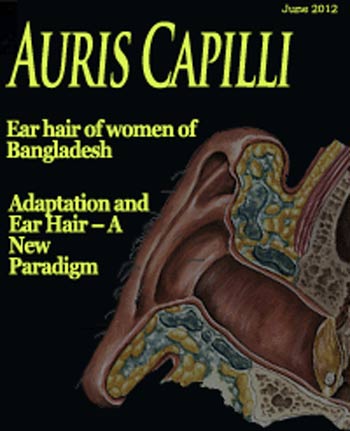Ear Hair Increases With Age And May Save Humans From Effects Of Meteorite Impact
By MINDY PEARLESTEIN
Published August 11, 2012
 BOULDER, CO — Auricular folliculars (or “ear hair”) is perceived to be age-related and much more frequent in the old than in the young. A University of Colorado Auricular Follicular Center review published August 12 in the journal Auris Capilli may establish without question that advanced age increases the risk for unwanted ear hair. It also observes that ear hair could give rise to new adaptive traits in humans.
BOULDER, CO — Auricular folliculars (or “ear hair”) is perceived to be age-related and much more frequent in the old than in the young. A University of Colorado Auricular Follicular Center review published August 12 in the journal Auris Capilli may establish without question that advanced age increases the risk for unwanted ear hair. It also observes that ear hair could give rise to new adaptive traits in humans.
“If you look at Mick Jagger in 1960 compared to Mick Jagger today, it’s obvious that his ear hair prevalence has changed,” says Thomas DeGregori, PhD, investigator at the University of Colorado Ear Hair Center and professor of aural folliculars at the University of Colorado School of Medicine. “It is the change in the ear tissue that drives more ear hair growth as we grow older.”
For evidence, DeGregori points first to the fact that by the time we stop reach our late-40s we already have accumulated a large fraction of the ear hair sites we will have in our lifetimes.
 Second, DeGregori points out that even pristine ear lobe tissues are full of hair shafts that will develop over time. “These mutations are many times more common than the cancers associated with them,” DeGregori says. Simply, more mutations doesn’t equal more cancer -- not across the aging population and not even in specific tissues.
Second, DeGregori points out that even pristine ear lobe tissues are full of hair shafts that will develop over time. “These mutations are many times more common than the cancers associated with them,” DeGregori says. Simply, more mutations doesn’t equal more cancer -- not across the aging population and not even in specific tissues.
DeGregori’s final points come from evolution. As we’ve evolved from one-celled, short-lived life forms into multi-cellular, long-lived humans, we’ve had to develop complicated machinery to grow hair on our heads and bodies.
“But we struggle to avoid growing hair in places we do not want it,” DeGregori says. “You'd think if avoiding hair growth in unwanted places were so important, we would be better at it.” Perhaps, said, DeGregori ear hair is the sign of a mutation that could lead to some adaptive traits.
“It is hard to say what function ear hair could serve, whether to protect the ear canal or to create loft such as feathers.”
“It’s like what happened to the dinosaurs 65 million years ago,” DeGregori says. “Dinosaurs were great as hairless beasts – they were well adapted to their landscape. Then the meteor hit. Those dinosaurs that grew feathers were better adapted to the changed landscape because they evolved to take to the skies.”
DeGregori postulates that human ear hair may be a precursor to an adaptive trait similar to feathers. “It is hard to say what function ear hair could serve, whether to protect the ear canal or to create loft such as feathers.” If only we could stick around long enough to find out.




